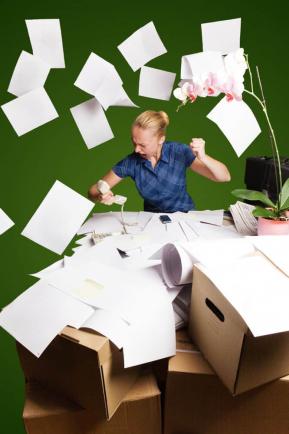
Staying organized in the office is a bigger challenge today than it was thirty years ago. In the olden days, offices were full of people - clerks, secretaries and assistants - who did nothing but organize the constant flow of paper.
With the advent of computers and tighter budgets, most organizations operate with almost no clerks or assistants (and of course, almost no one outside of the President's cabinet is called a secretary anymore). So, here are some tips to help you keep your work space clean and organized.
1. Get four deep inbox style baskets
Religiously add paper that comes into your office to the baskets in order. Fill each one in turn slowly over a period of months. You may find that four baskets will hold more than one year of paperwork. Remembering that most of the information you need is archived electronically somewhere, most of the material in your baskets will eventually become garbage.
By consistently adding paper to the baskets in order, you can quickly find a document that you may need (it will happen rarely) in under one minute. When all the baskets are completely full, take 20 minutes to go through the entire pile of stuff. Most of the material will obviously be ready for the recycling bin. Anything that is still relevant after one year should get filed into your permanent filing system.
If you are screening material carefully, however, your permanent files should be lean and you won't spend much time organizing them. This system will prevent you from accumulating a tsunami of paperwork on your desk and should require only 20 minutes per quarter to maintain.
2. Do it, don't plan it
Sometimes when you get a piece of paper, it corresponds to a task - a bill to be paid, a form to be completed and returned, an authorization to sign and pass along. If such items can be completed in less than two minutes, do it when it arrives and get the paper off your desk and the monkey off your back. If it will take more than two minutes, put it in your action pile to be completed before you leave for the day.
3. Have a place for business cards
Most email systems can be set to record the email address of everyone to whom you send an email. This eliminates the need to manually record email addresses, but you may not be capturing phone numbers and addresses. When you get a business card, toss it in a box in a drawer out of sight where you can find it should you ever need it. Rely primarily on your electronic Rolodex to gather your contact information.
4. Use LinkedIn
Invite virtually everyone you meet to connect on LinkedIn. This will enable you to receive updated contact information for them throughout your career - and to share yours with them. This eliminates much of the need for actively managing your Rolodex. (If you aren't using LinkedIn, remember that other people use it just this way. You will never be in their Rolodex to get a call for anything.)
By using these simple, time-saving tips you can efficiently organize your work space so that it is always ready for the boss to stop by to say hello.

